20-Second Summary
Biomass energy remains one of the most debated renewable energy sources globally.
As per the stats from Statista, the US was producing about 3,262 petajoules of biomass energy in earlier years, which has increased to 4,992 PJ in 2024, which demonstrates the growing adoption of this bioenergy from biomass.
The US is further planning to expand bioenergy using government initiatives for expanding the production of biomass and setting up the renewable fuel standards as a part of its national strategy to reach net-zero emissions by the year 2025.
However, the question is biomass renewable or nonrenewable depends on three factors:
- How sustainably it’s managed
- How it is harvested
- How it is processed
Even though biomass renewable energy sources can be regenerated with human efforts, relying on unsustainable practices can transform them into carbon-intensive fuels that rival fossil fuels.
What is Biomass Energy?
Biomass energy is an organic source of renewable energy used to produce heat, electricity, or biofuels and is derived from the living organic materials, including plants, animals, and their waste, as well as organic materials found in municipal solid waste and vegetable oils or animal fats.
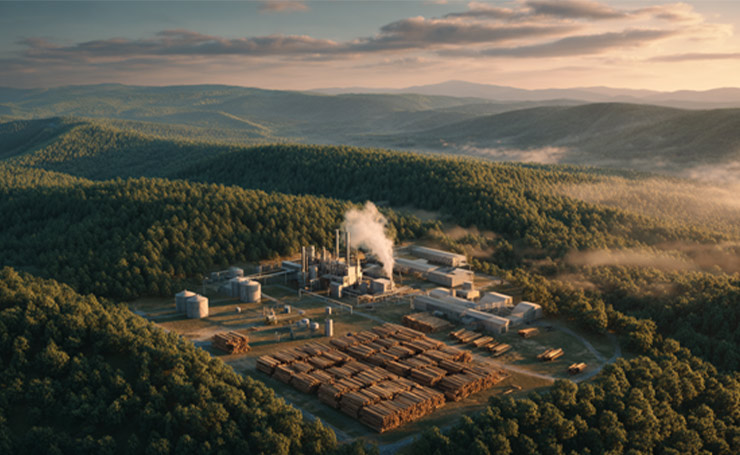
Biomass Energy is one of humanity’s oldest energy sources, dating back to the discovery of fire.
These organic and waste materials are converted into biomass energy with the help of processes like combustion, gasification, and biological conversion.
Types of Biomass Energy Sources
Different types of biomass energy sources are converted into biomass energy using different techniques and technologies to provide energy in the form of heat, biofuels, or electricity. These biomass energy sources, along with their example,s are given below:
- Wood waste and forestry residues: sawdust, bark, logging slash, and wood chips
- Crop residues: corn stalks, wheat straw, rice husks, and sugarcane bagasse
- Energy crops: switchgrass, miscanthus, willow, and poplar, specifically grown for fuel
- Animal waste: manure from livestock operations converted into biogas
- Municipal solid waste: organic fraction of household and commercial waste
- Aquatic biomass: algae and seaweed with rapid growth rates
Is Biomass Renewable or Nonrenewable?
Let us get into the details of whether Biomass is a renewable or non-renewable source.
Difference between Renewable and Non-renewable Energy Resources
Non-renewable energy sources like fossil fuels are those that take millions of years to form, and when used up, they cannot regenerate or be replaced easily.

On the other hand, the renewable energy resources are those that depend on the human regeneration timeframes and also on their sustainable power. They can be reproduced and replenished naturally with consistent human efforts, hence making the energy generation continuous, an unfinished cycle.
However, the classification of biomass energy into a renewable or non-renewable resource depends entirely on management practices, harvest rates, and biomass carbon cycle dynamics.
Biomass as a Renewable Source
Biomass is generally classified as a renewable source of energy because it comes from the organic matter that can be regenerated and replenished quickly with human efforts.
Some examples of the replenishment of the renewable sources along with their time frames are given below:
- Trees can reach maturity in 20-60 years
- Agricultural crops regrow annually
- Animal waste is produced continuously
The requirement of biomass to be regarded as a renewable source requires the biomass carbon cycle to operate within the biosphere-atmosphere system.
- When plants grow, they absorb atmospheric CO₂ through photosynthesis. When biomass burns, it releases this stored carbon back into the atmosphere, theoretically creating a closed loop.
- If harvesting rates don’t exceed regrowth rates, the system remains balanced and sustainable.

Biomass as a Non-renewable Source
Biomass can easily act as a non-renewable source if it is not replenished effectively after being used. There are certain factors that could turn biomass into a non-renewable source.
- Not replanting the trees after deforestation to use wood as biomass fuel.
- Overharvesting without proper measures, which ends up degrading the land’s fertility, making it less fertile to grow biomass, again leading to land and biomass depletion.
- Not using the organic waste to produce biomass energy and letting it sit there without proper management, it ends up as a landfill instead of a renewable source of energy.
Biomass vs Fossil Fuels
The main difference between biomass and the fossil fuels is in their capacity to replenish and their carbon cycle.

- Oil, coal, and gas are fossil fuels that took millions of years to form and contain carbon sequestered millions of years ago.
- When fossil fuels are consumed, they release carbon, increasing the CO2 concentration in the environment without having the ability to replenish quickly to mitigate these effects.
- Biomass, on the other hand, has an active carbon cycle, where, upon being consumed, it does release the carbon into the active biosphere environment, but then it is also replenished by human beings in a short time frame by producing the crops and trees that can absorb the biomass-produced carbon, neutralizing the carbon buildup by reabsorption.
- The renewability timeframe of fossil fuels can be from 50 to 300 million years, while for biomass it takes from a few days to decades to regenerate the biomass sources, like algae can take days and weeks to grow, crops can be regrown annually, and the fast-growing trees can take 5 to 20 years for growth to be used again as a biomass energy source.
Biomass vs Other Renewable Sources
While we have compared it with fossil fuels (non-renewable source of energy), let us have a brief yet significant look at its comparison with other renewable sources to have an outlook at its active participation as an environmentally friendly energy source.
| Energy Source | Carbon Footprint (g CO₂/kWh) | Resource Renewal Time | Infrastructure Cost | Environmental Considerations | Current Adoption |
| Biomass | 50-100+ | Years to decades (varies by feedstock) | Moderate | Land use concerns, deforestation risk, and food competition | Widely used for heat/power from waste |
| Solar PV | 10-50 | Continuous sunlight | Moderate-High (declining) | Low emissions, requires land, manufacturing impact | Rapid global growth |
| Wind | 7-15 | Continuous wind flow | Moderate | Minimal emissions, wildlife/visual concerns | Major deployment worldwide |
| Hydropower | ~20 (can vary) | Hours to days (water cycle) | High initial cost | Ecosystem disruption, habitat flooding | Largest renewable source |
| Geothermal | 6-40 | Effectively unlimited | High drilling costs | Low impact, geography-limited | Niche but growing |
| Ocean/Tidal | 5-20 (estimated) | Inexhaustible tides | High (emerging tech) | Marine habitat concerns | Limited deployment |
Important Considerations:
Although biomass can provide on-demand dispatchable power and waste utilization without an extensive grid infrastructure, it still has the slowest regeneration rate and highest carbon footprint as compared to other renewable energy sources like solar and wind energy, and it requires consistent efforts to replenish it using sustainable regrowth and sustainability practices.
How Biomass Works: Energy Conversion Technologies
To understand how biomass works in energy conversion, we must look at the main conversion processes involved in the production of biomass energy.
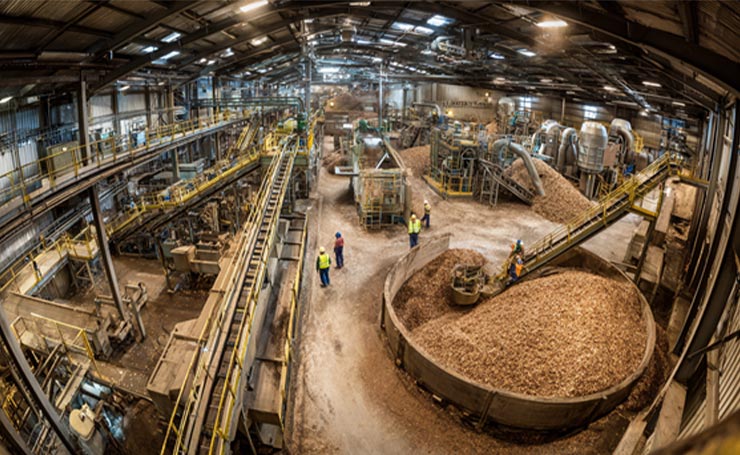
Thermochemical Conversion
In thermochemical conversion of biomass into energy, usually four processes are used.
Direct Combustion
In the combustion process, Biomass is burned directly to produce heat, which generates steam to drive turbines for biomass electricity generation.
Its applications are given below:
- Residential heating (wood stoves, pellet boilers)
- Industrial process heat (paper mills, food processing)
- Power generation (dedicated biomass plants, 20-100 MW capacity)
- Combined heat and power (CHP) systems achieve 80-90% efficiency
Gasification
Biomass is heated to 700-1,300°C with controlled oxygen, breaking molecular bonds to produce syngas, which can then be combusted for electricity, converted to synthetic natural gas, or processed into liquid biofuels.
Syngas is a mixture of gases like hydrogen, carbon monoxide, and methane.
Pyrolysis
Biomass is heated to 400-600°C without oxygen, which produces three products
- Pyrolysis oil (bio-oil), which is a liquid fuel similar to petroleum crude
- Syngas that is used for heat or electricity
- Biochar, a carbon-rich solid for soil amendment and carbon sequestration
Torrefaction
Converts solid biomass (like wood chips or agricultural waste) into a higher-quality, coal-like solid fuel called bio-coal.
It can be thought of as a step done before the liquefaction process of thermochemical conversion.
Liquefaction
In the liquefaction process, heat is used along with pressure to break down complex organic molecules into the bio-crude oil, which is later on refined and used as a transportation fuel like diesel.
Biochemical Conversion
In biochemical conversion of the biomass, microorganisms are used in processes like fermentation and anaerobic digestion to break down the biomass into biofuels, chemicals, and energy.
Anaerobic Digestion
- In the anaerobic digestion process, microorganisms break down organic matter in oxygen-free environments.
- The organic matter that is used as the feedstock in this process includes: animal manure, food waste, municipal wastewater sludge, and energy crops.
- This process produces biogas, which is 60% methane and 40% CO₂.
- After purification, biomethane can substitute natural gas in pipelines, vehicles, or electricity generation.
- Beijing’s Deqingyuan chicken farm converts manure from 3 million chickens into 14,600 MWh of electricity annually through gasification.

Fermentation
In the fermentation process, the sugars and starches in biomass are fermented by yeast or bacteria to produce ethanol, which can be used as a biomass biofuel for transportation.
- The process involves the breakdown of the cellulose from the feedstocks, then, using the enzymatic hydrolysis, the cellulose is converted into the fermentable sugars.
- Fermentation then transforms these sugars into ethanol, which is further purified using distillation to convert it into fuel.
- The Feedstocks include corn, sugarcane, wheat, and cellulosic materials (switchgrass, wood chips, agricultural residues).
- The US produces approximately 15 billion gallons of ethanol annually, primarily from corn.
Some state direct combustion as a separate physical way of converting the biomass into energy, but it usually comes under the thermochemical conversion, hence not mentioned separately here.
Biomass Sustainability, Carbon Cycle, and Lifecycle Emissions
For biomass to remain a renewable energy source, it is very important to consider its carbon lifecycle accounting along with the sustainable practices of humans.

- If the system of generating biomass energy is closely monitored, we can maintain a healthy short-cycle biomass carbon cycle where the carbon released during the conversion of biomass can be offset by the uptake of the carbon by re-growing the biomass.
- On the other side, due to the unmanaged soil carbon supply and lack of biomass feedstocks or with long transport requirements to move the biomass sources, the lifecycle emissions from biomass generation can exceed those of fossil fuels and may impact the environment badly.
Therefore, it is required to manage the biomass replenishment strategies by increasing the biomass sources to compete with the CO2 emissions with adequate reabsorption, and also to minimize the supply chain emissions.
Environmental Impact: Advantages & Disadvantages
Biomass can have both positive and negative impacts on the environment based on many factors that have been listed below.
Advantages of Biomass Energy
When properly managed, biomass provides the following advantages.
Waste reduction
Using organic residues and waste streams for energy supports a biomass and waste-to-energy model.
- OECD countries use biomass as a waste-to-energy system to convert 65-80 million tonnes of municipal solid waste from landfills into usable energy to reduce methane emissions.
- Waste-to-energy plants generate 850 kWh per tonne of waste while reducing landfill volume by 90%.
Renewable Supply
Biomass has a renewable supply, as its feedstocks can be regenerated by using cropping, animal dung, and the municipal wastes that keep generating with more and more human usage.
- Global biomass supply potential is projected to reach 2.13 billion by 2030 from 1.32 billion dry tonnes.
- This can be done with a renewable supply of the feedstocks using the improved agricultural productivity and dedicated energy crop cultivation.

Carbon-cycle Benefits
Biomass can provide great carbon cycle benefits if it is properly managed, as its new production at the same speed as its usage can help to mitigate the excessive emission of CO2 through reabsorption with the latest growth.
Employment in Rural Areas
With an increase in the consumption of biomass energy along with its regrowth, the employment opportunities in this sector in the rural areas increase.
Biomass as a Co-product
Biomass can also be used as a co-product to add more to its sustainability for the environment in the following ways:
- During the pyrolysis process, a charcoal-like substance called biochar is produced, which can be used to increase the fertility of the soil.
- While generating the biodiesel from the animal fats and vegetable oils, glycerine is also produced as a byproduct.
- Dried distillers’ grains from the fermentation of corn and other grains to produce ethanol carry significant market value as a high-protein feed for animals.
Disadvantages of Biomass Energy
When not properly managed, biomass can have an adverse impact on the environment.
Potential Deforestation
Biomass sustainability relies on the proper management for replenishing the feedstocks. If the forests are being used for biomass energy, but not being planted at the same rate, then potential deforestation can exist.
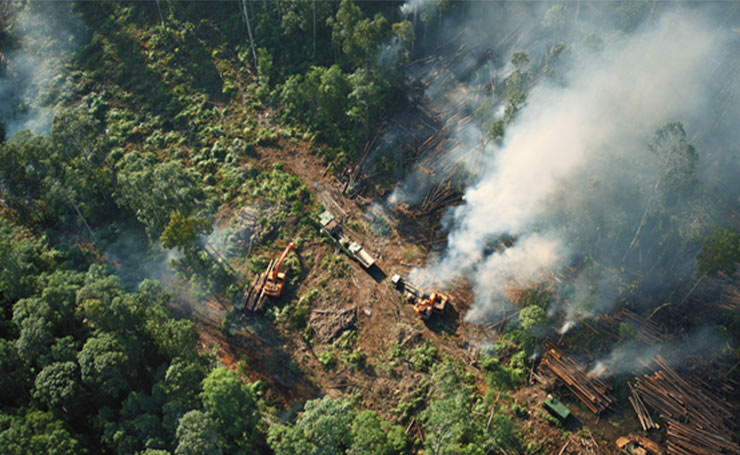
High GHG if Mismanaged
With an unmanaged supply chain, exceeding biomass transport emissions, and unhealthy land utilization, the greenhouse gas effect can increase in the generation of biomass energy, impacting the environment negatively.
Land-use Competition
With more land requirements for growing the biomass crops, the lands used for crops come into conflict.
With the expansion of biomass production, the land available for food crops can be depleted, which results in decreased food supply and increased pricing.
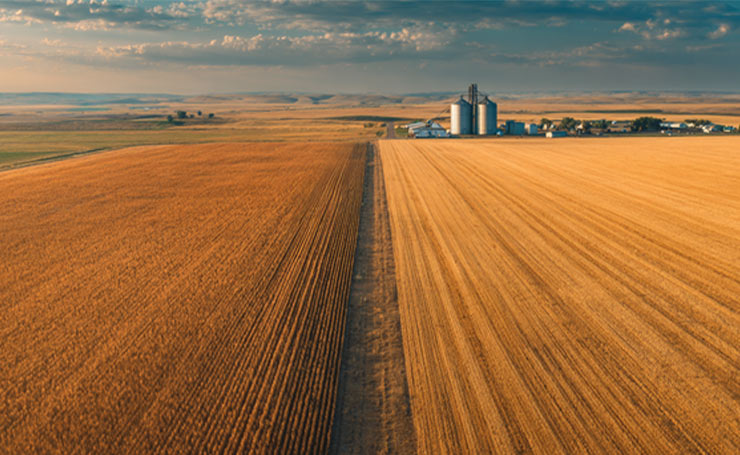
Supply Chain Emissions
Harvesting, transport, and conversion can introduce fossil energy inputs, reducing net benefit.
Air Quality Concerns
Biomass combustion releases particulate matter (PM2.5, PM10), nitrogen oxides (NOx), carbon monoxide (CO), and VOCs, which, without modern emission controls (scrubbers, filters, catalytic systems) in the biomass facilities, can emit more pollutants than natural gas plants.
Biomass Policies, Incentives & Energy Technologies
Government policies and financial incentives are rapidly reshaping what’s possible and profitable in the biomass energy industry.

Let’s have a look at the top five biomass developments that matter the most:
1. The U.S. Government Now Pays You to Use Biomass
The 2022 Inflation Reduction Act gives homeowners 30% back (up to $2,000) when they buy EPA-certified biomass stoves or boilers. Biofuel producers also get tax credits that adjust based on how much they reduce emissions.
2. Europe Sets Strict Rules on Which Biomass Counts as Green
The EU’s 2023 directive bans most food-crop biofuels and requires proof that forest biomass doesn’t harm biodiversity. By 2030, 29% of transport energy must come from renewables, with at least 5.5% from advanced biofuels made from waste.
3. BECCS Technology Actually Removes Carbon from the Air
Unlike other renewables that just avoid emissions, Bioenergy with Carbon Capture and Storage burns biomass for energy while capturing the CO₂ and storing it underground. This creates carbon-negative energy and can reverse past pollution.
4. Next-Generation Biofuels Avoid the Food vs Fuel Debate
Scientists now make ethanol from corn stalks instead of corn kernels, diesel from used cooking oil, and jet fuel from wood waste. These advanced biofuels don’t compete with food crops.
5. Brazil Shows Biomass Works at Massive Scale
Brazil produces more bioethanol from sugarcane than any country on Earth. Every gas station sells fuel with 27% ethanol mixed in, proving biomass can power millions of vehicles when done right.
Top 3 Biomass Energy Projects: Real-World Performance in 2024-2025
Below is a detailed breakdown of the top three biomass energy projects from real-world with their performance in 2024-2025, including their key role in achieving CO2 emission control and the key challenges they faced.
| Project | Location | Biomass Type & Source | Capacity & Output | Recent Accomplishments (2024-2025) | Key Challenges |
| Drax Power Station | North Yorkshire, UK | Wood pellets from low-grade timber, sawmill residues, and forest thinnings. Sources from North America, Baltic States, and Brazil (7 million tonnes annually) | 2.6 GW generating 5-6% of UK electricity | Generated 25% more renewable power in 2024; Secured contract extension through 2031; Produced 4 million tonnes of pellets from 18 certified facilities | Fined £25 million in 2024 for misreporting wood sources; Subsidies cut by 50% from 2027 onward; Remains UK’s largest single carbon emitter at 13.3 million tonnes CO2e; California expansion plans canceled in July 2025 |
| McNeil Generating Station | Burlington, Vermont, USA | Wood chips from forest harvest residues and low-grade timber within a 60-70-mile radius (Vermont and upstate New York). Burns 400,000-500,000 tons annually | 50 MW (provides one-third of Burlington’s electricity) | Generated 68.5 GWh between December 2024 and March 2025; Operates with 4 professional foresters that ensures sustainable harvesting standards; 2024 report found no viable replacement for grid reliability | Lost $8.54 million in the first 10 months of fiscal 2024; Facing strong local opposition; Vermont’s largest carbon emitter at 453,000 tonnes CO2e annually; Debate over the sustainability of feedstock sourcing practices |
| Brazilian Sugarcane Ethanol Industry | Brazil (national program) | Sugarcane and bagasse (crushed cane residue). 654-676 million tonnes of sugarcane processed in the 2024 harvest. Crushed Cane Residue provides 22% of the industry’s energy needs | 356 plants producing 36.83 billion liters of ethanol in 2024 | Record-breaking 2024: 36.83 billion liters produced with a 4.4% increase; Prevented 48.6 million tonnes of CO2 emissions; Self-sufficient energy generation with surplus electricity exported to the grid; 90% GHG reduction when compared to gasoline | 2025 harvest facing 2.3% production decline due to drought and fires; Sugarcane productivity dropped 1.65% in the center-south region; Rising eucalyptus biomass costs (from R$120 to R$240-500 per ton in 6 years) |
Biomass Energy Future: Role in Renewable Energy Transition
- The global bioenergy market is growing fast. It was worth $145–296 billion in 2024 and is expected to keep rising at 7–8% every year through 2033.
- Asia-Pacific is leading the way, growing at a 10.8% annual rate. China is expanding its biomass power capacity quickly, and India’s new clean fuel rules are adding more momentum.
- In North America, bioenergy is well-established. The region holds 33.8% of the global market, and the US exports over 846,000 tonnes of biomass pellets each month to Europe.
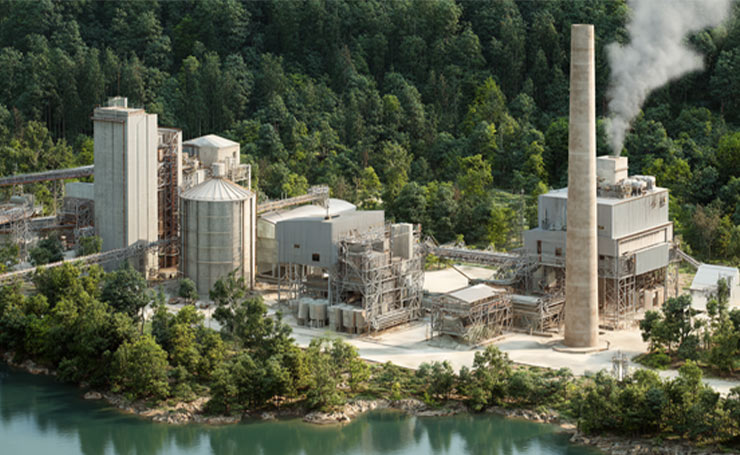
- Europe remains the top market, with 37.12% of total global revenue in 2023. New sustainability rules under RED III may slow growth slightly, but will make the industry more eco-friendly in the long run.
- New technologies like gasification and plasma-based systems are making waste-to-energy plants cleaner and more efficient than older methods.
- Today, modern bioenergy provides more than half of the world’s renewable energy, helping balance electricity grids, store energy for seasonal use, and cut emissions in industries that are hard to electrify.
Final Remarks
Biomass energy can be a great renewable energy source when managed efficiently from its growth and supply chain to its application and regrowth time-frame management, but when not managed properly, it can easily turn into a non-renewable energy source that can impact the environment negatively.
If you are interested in knowing about other renewable energy sources, then do not forget to read our take on Solar Energy and Wind Energy.
Frequently Asked Questions
Is biomass a renewable or nonrenewable energy source?
When properly sourced, managed, and converted into energy, biomass can indeed act as a renewable form of energy. But without sustainable practices of the regrowth of biomass crops to reabsorb the CO2 emitted during bioenergy generation and increased supply chain costs, it can turn into a non-renewable source of energy.
How does biomass energy work?
Biomass energy works by converting organic feedstocks into heat, electricity, or biofuels by using techniques such as combustion, thermochemical, or biochemical conversion.
How is biomass different from fossil fuels?
Fossil fuels are non-renewable energy sources that take millions of years to form and can cause carbon emissions, while biomass can be produced in short time frames with a healthy carbon lifecycle to reabsorb the carbon emitted during the generation of biomass energy from organic biomass feedstock.
Why is biomass considered renewable?
Because plants and organics used in biomass energy generation can regrow, absorb CO₂, and be turned into energy in a cycle that can repeat within human timescales.
When can biomass become nonrenewable?
Biomass becomes non-renewable when the feedstock becomes depleted, and the land required to grow biomass crops becomes infertile due to poor supply chain management.

